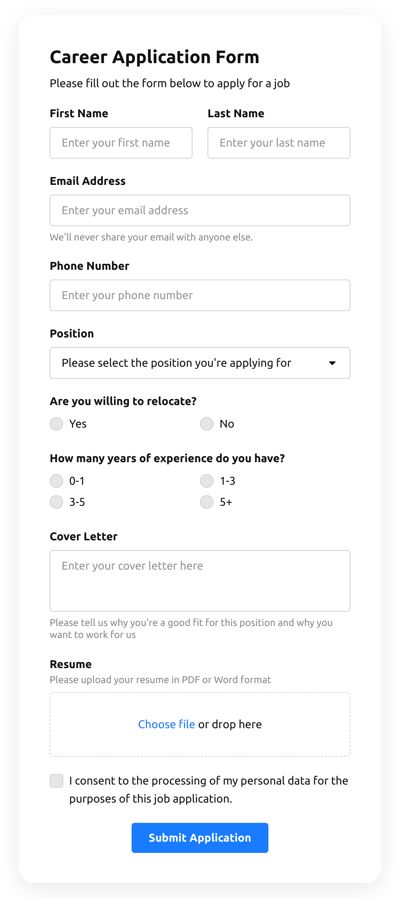Floating Form Template
- AI-Powered Form Generator
- Spam Protection
- Multiple Email Alerts
- Pre-Fill Forms with URL Params
- Post-Submit Actions
- Multi-Step Forms
- Multilingual Forms
- Transfer All Data
- Submit Files
- Mobile Responsive
- 20+ Customizable Fields and Elements
- Floating Layout
- Color Theme Generator
- Multiple Layout Designs
- More than 5000 Zapier-Based Integrations
Need a Different Template?
Here’s what people say about Elfsight Form Builder widget
FAQ
How to Create Your Own Floating Form Template for the Website
In order to design the Floating Form template for your website, follow this instruction:
- Pick from a catalog the Floating Form template.
- Open the chosen template.
- Press the “Use Template” option.
- Customize all the attributes and characteristics of the Floating Form to match the website style.
- Log in to the Elfsight account and receive the code to embed.
How to Customize the Floating Form for Your Website Layout
It’s as simple as it seems; just navigate to the “Appearance” menu in the configurator. Choose the layout template. Modify width and position. This is it!
How to Add Floating Form Plugin to the Website
To enter the Floating Form plugin to the site, complete the brief instruction:
- Modify the Floating Form template.
- Sign in to the Elfsight account.
- Obtain the individual widget code and copy it.
- Go to the website and integrate the code into the HTML editor.
What Integrations are Available for Floating Form
For our beloved clients, we provide Mailchimp, Google Sheets, and over 5000 integrations via Zapier! Creating a practical Floating Form doesn’t mean you have to be a rocket scientist. With the proper template, you can easily make an effective form for your particular case.
| Mailchimp Integration | This app integration allows users to easily run and manage regular email marketing campaigns, gather client’s contacts, and track the performance metrics. |
| Google Sheets Integration | This integration lets users access and adjust data kept in their Google Sheets account from other apps and services. For example, you can utilize this application integration to transfer your form results. |
| Gmail Integration | This integration lets users access their Gmail messages, contact details, and calendar events from different applications and services. |
| CRM Integration | This integration service allows businesses to access customer details from multiple sources in one place, simplify processes, and improve customer service. |
| Zapier Integration | This app integration allows users to sync apps and services with one another to automate workflow processes and swap details rapidly. |
How to Add Integration to Your Floating Form
In order to enter an integration to your Floating Form, complete the steps from the brief instruction:
- Navigate to the “Integrations” menu option inside the demo builder.
- Select an integration.
- Sync the form to the chosen application integration and authorize the account.
What to Look for When Customizing Your Floating Form
Form Title
The form’s caption should clearly describe what customers are completing. Express your brand presence by keeping the title brief, sweet, and catchy. This will help users easily get the idea why they’re submitting the Floating Form and how their data ends up being used.
Floating Form Input Fields
This is where customers shall input their first and last name, email address, message, as well as any other applicable information you desire to collect from visitors.
Floating Form Submit Button
This is an essential element of any form considering that it lets clients release when their own info has been effectively sent.
Privacy Policy
Don’t forget to include a hyperlink to your site’s privacy notice in your Floating Form so that clients understand how their information will be utilized and protected by your company or organization.
Floating Form Anti-Spam Captcha
Including an anti-spam captcha helps prevent spam submissions while making sure only real users are accessing the form information and not bots.
Confirmation Message
After a client has successfully filled out and submitted the Floating Form, make sure they get some confirmation message that their submission was sent and is being taken care of by your support team or firm.
Floating Form Mobile Optimization
Build the form mobile-friendly for each mobile device by using an adaptive layout. It’s easy-to-use on any screen size, browser, operating system, and orientation. Additionally, correctly display all of the fields, labels, and directions to get a clear and concise outcome.
Floating Form Visuals
Create a great user experience on your webpage by adding visuals. Think about using pictures, symbols, or eye-catching colors to emphasize the submit button or call-to-action (CTA). But attempt to avoid using various colors and visuals, as it can be intimidating and distract from your core message.
Floating Form Fields Validation
Including field validation helps reduce mistakes that may occur when users enter inaccurate information. Validate the essential fields in no time, so customers know when they have made an error and can adjust their details before sending the form.
Help with Floating Form Setup and Website Installation
If you have read through the guidelines and still have a few doubts, check out the next choices:









